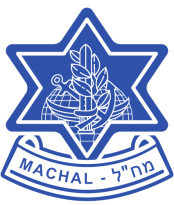CATEGORY – PERSONAL STORY 1947-49
RAYNER, Leslie Michael – Engineering Corps, specialist in mines and demolition
LESLIE MICHAEL RAYNER
Coming from a family of Zionists, and sickened by the British Government’s actions with regard to attempts by Jewish survivors to get to Palestine, I left my job and made my way there, arriving in Palestine in November 1947 to join the Haganah as a military engineer. I had previously served with the Royal Engineers of the British Army from 1940-1946, which included 18 months in the Western Desert theatre of war. My specialty was mines, demolition and all field engineering. Later I officially served in the field engineering branch of the I.D.F. as deputy to the 4th Brigade (Kiryati) engineer, with the rank of major.
At the outset, I supervised construction of defenses, gun emplacements and so on, followed by laying minefields, as well as the demolition of enemy properties within the area of central command. I was on my own, as the unit I served in did not include other Machalniks.
Officially, I joined Machal at an office which was in fact the private residence of an Englishman residing in Tel Aviv; he organized the records and monthly payments to Machal, in addition to our monthly army pay of ₤3. These small amounts of pocket money were donated by British and other Jewish organizations.
Whilst in charge of fortifying a disused plywood factory on the Tel Aviv-Jerusalem highway at the Bet Dagan junction, we were subjected to two attacks by Arab forces, and in spite of having limited weapons and small amounts of weapons, we were able to repulse them. Two British policemen and a service officer were included in the forces attacking us..
As C.O of a small unit of field engineers in the belated attack on Latrun from Kibbutz Hulda, we were outgunned by the Arab Legion stationed in Latrun with field guns, but we were able to lay a provisional minefield to delay any Arab advance on our withdrawal from Hulda.
An Anecdote:
A large amount of explosives (gelignite) had been laid in an old Roman drain outside the Old City walls, with the intention of blowing out an entrance for another attempt to recapture the Old City. This was postponed and later abandoned, as the amount of destruction could not be envisaged.
I was then put in charge of a small unit, and we collected quite a large amount of somewhat unstable gelignite from the Tel Aviv – Petach-Tikva area, and proceeded in convoy at night to transport this dangerous material to destroy Arab positions near the Arab village of Deir-Natif in the Jerusalem hills. We loaded the explosive into a disused well, detonating it electronically to ascertain the damage caused. The result made the Central Command remove the explosives in the Roman drain of the Old City, and it had to be removed by hand by a group of volunteers.
Machal/leslierayner131009finaljoe281009
Coming from a family of Zionists, and sickened by the British Government’s actions with regard to attempts by Jewish survivors to get to Palestine, I left my job and made my way there, arriving in Palestine in November 1947 to join the Haganah as a military engineer. I had previously served with the Royal Engineers of the British Army from 1940-1946, which included 18 months in the Western Desert theatre of war. My specialty was mines, demolition and all field engineering. Later I officially served in the field engineering branch of the I.D.F. as deputy to the 4th Brigade (Kiryati) engineer, with the rank of major.
At the outset, I supervised construction of defenses, gun emplacements and so on, followed by laying minefields, as well as the demolition of enemy properties within the area of central command. I was on my own, as the unit I served in did not include other Machalniks.
Officially, I joined Machal at an office which was in fact the private residence of an Englishman residing in Tel Aviv; he organized the records and monthly payments to Machal, in addition to our monthly army pay of ₤3. These small amounts of pocket money were donated by British and other Jewish organizations.
Whilst in charge of fortifying a disused plywood factory on the Tel Aviv-Jerusalem highway at the Bet Dagan junction, we were subjected to two attacks by Arab forces, and in spite of having limited weapons and small amounts of weapons, we were able to repulse them. Two British policemen and a service officer were included in the forces attacking us..
As C.O of a small unit of field engineers in the belated attack on Latrun from Kibbutz Hulda, we were outgunned by the Arab Legion stationed in Latrun with field guns, but we were able to lay a provisional minefield to delay any Arab advance on our withdrawal from Hulda.
An Anecdote:
A large amount of explosives (gelignite) had been laid in an old Roman drain outside the Old City walls, with the intention of blowing out an entrance for another attempt to recapture the Old City. This was postponed and later abandoned, as the amount of destruction could not be envisaged.
I was then put in charge of a small unit, and we collected quite a large amount of somewhat unstable gelignite from the Tel Aviv – Petach-Tikva area, and proceeded in convoy at night to transport this dangerous material to destroy Arab positions near the Arab village of Deir-Natif in the Jerusalem hills. We loaded the explosive into a disused well, detonating it electronically to ascertain the damage caused. The result made the Central Command remove the explosives in the Roman drain of the Old City, and it had to be removed by hand by a group of volunteers.

